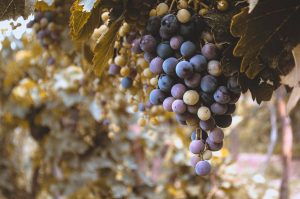Grapevines are among the most rewarding perennial crops to grow, offering fruit for fresh eating, winemaking, or ornamental landscapes. By October, vines have largely completed their harvest cycle and are preparing for dormancy. While it may appear that growth has slowed, this is actually one of the most critical times to support the vines with proper nutrition. The right nutrients now determine how well grapevines endure winter and how vigorously they emerge in spring. One of the most effective fall nutrients for grapevines is potash (muriate of potash, or potassium chloride).
Potash provides potassium, an essential macronutrient that strengthens tissues, enhances sugar transport, and improves resilience. Grapevines that receive adequate potassium before dormancy store more energy, resist cold stress, and produce healthier buds for the following season. Without potassium, vines risk weakened canes, poor bud development, and reduced fruit quality.
At Supply Solutions LLC, muriate of potash (0-0-60) is available to help growers, landscapers, and gardeners strengthen grapevines and improve winter hardiness.
Why Potassium is Critical for Grapevines
Potassium is often called the quality nutrient because of its influence on fruit crops like grapes.
- Sugar Transport: Potassium helps move carbohydrates into roots and storage tissues.
- Bud Strength: Vines with adequate potassium form healthier, more viable buds.
- Cold Resistance: Potassium strengthens cell walls and improves tolerance to frost.
- Disease Resistance: Stronger tissues reduce the risk of fungal and bacterial infections.
- Balanced Growth: Potassium supports root development and overall vine structure.
Grapevines deficient in potassium often show scorched leaf edges, weak canes, and poor fruit development.
Why October Applications Matter
Fall applications of potash provide targeted benefits at the right time.
- Dormancy Preparation: Nutrients are stored in canes and roots for spring growth.
- Stronger Canes: Potassium hardens wood, reducing dieback during winter.
- Bud Viability: Well-fed vines form buds that are more likely to survive frost.
- Improved Root Storage: Carbohydrates transported into roots improve energy reserves.
- Spring Readiness: Nutrients are immediately available as vines emerge from dormancy.
Applying potash before the ground freezes ensures vines have time to absorb and store potassium.
Benefits for Vineyard Farmers
For commercial vineyard managers, fall potassium applications directly impact profitability.
- Higher Yields: Stronger vines produce more consistent fruit set.
- Better Fruit Quality: Potassium improves sweetness, color, and flavor.
- Reduced Winter Losses: Stronger canes and buds survive cold weather better.
- Efficient Fertility Programs: Fall applications complement nitrogen and phosphorus applied earlier.
- Sustainable Management: Consistent potassium levels reduce nutrient imbalances.
Farmers who add potash in October protect their vines and future harvests.
Benefits for Landscapers
Grapevines are increasingly popular in landscapes for arbors, fences, and ornamental plantings. Landscapers can use potash to enhance these plantings.
- Healthier Vines: Potassium supports lush foliage and stronger canes.
- Attractive Arbors: Nutrient-rich vines create fuller coverage on trellises.
- Client Value: Demonstrating knowledge of potassium needs builds trust.
- Reduced Maintenance: Stronger vines are less susceptible to disease and dieback.
For landscapers, potash helps create ornamental grapevines that thrive season after season.
Benefits for Home Gardeners
Home gardeners with backyard grapevines also benefit from potash applications in fall.
- Stronger Plants: Potassium reduces dieback and increases longevity.
- Better Grapes: Potassium improves sweetness and fruit size.
- Winter Protection: Well-fed vines resist cold damage better.
- Ease of Use: Potash is easy to spread around vines.
For families growing grapes for eating or decoration, potash provides visible improvements.
How to Apply Potash to Grapevines
- Soil Test: Begin with a soil test to confirm potassium needs.
- Rates:
- Vineyards: 100 to 200 pounds of actual potassium per acre.
- Home vines: 1 to 2 pounds of muriate of potash per plant.
- Method: Broadcast evenly around the root zone or band near the dripline.
- Water In: Irrigate to carry nutrients into the soil.
- Timing: Apply in October before the ground freezes.
Common Mistakes to Avoid
- Skipping Soil Tests: Potassium should be balanced with calcium and magnesium.
- Overapplication: Excess potassium can interfere with magnesium uptake.
- Late Fertilization: Applying after frost reduces nutrient absorption.
- Nitrogen Overload: Too much nitrogen in fall weakens canes and delays dormancy.
Applying correctly ensures maximum benefits for grapevines.
Why Supply Solutions LLC
At Supply Solutions LLC, muriate of potash (0-0-60) is chosen for quality and consistency. Growers and gardeners can trust it to deliver potassium efficiently and effectively. With expert advice and reliable products, Supply Solutions LLC ensures vineyards and landscapes get the nutrients they need for resilience and productivity.
Grapevines Ready for Winter and Spring
Grapevines may rest during winter, but their preparation starts in fall. By supplying potassium through potash, farmers, landscapers, and gardeners strengthen canes, improve bud viability, and ensure vines emerge from dormancy healthier and more productive. The investment made now pays off in better fruit quality, higher yields, and more resilient vineyards.
For muriate of potash and other trusted fertilizers, visit Supply Solutions LLC. Reach us through our contact form, message us on Facebook, call 503-451-1622, or email sales@mysolutionssupply.com to get the products and guidance you need for stronger, healthier grapevines this fall.



